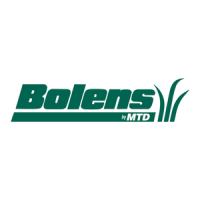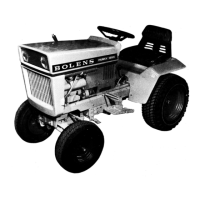Do you have a question about the Bolens HT-20 and is the answer not in the manual?
Emphasizes operator responsibility in preventing accidents and promoting safe operation.
Provides a richer fuel mixture for easy engine starting.
Indicates the rate of charge or discharge from the battery.
Controls the tractor's lighting system, with off and on positions.
Starts the engine by turning the key; also has off and run positions.
Controls the engine speed, allowing adjustment from idle to full throttle.
Used to apply brakes when the vehicle is moving or free-wheeling.
Controls forward and reverse motion; also used for dynamic braking.
Provides a place for the operator's foot when not operating controls.
Raises and lowers attachments; can be locked in FLOAT position.
Regulates auxiliary control cylinders on attachments connected to hydraulic ports.
Engages and disengages power to attachments like the PTO.
Secures the tractor in place by locking the foot brake pedal.
Indicates when the hydrostatic transmission and hydraulic system are overheated.
Tracks operating hours; available as an option through the dealer.
Indicates when engine oil pressure is low.
Ensure engine oil is within the proper operating range using the dipstick.
Verify sufficient gasoline supply, using fresh, clean regular or low lead gasoline.
Inspect battery for proper electrolyte level, clean cables, and clean terminals.
Ensure air cleaner element is free of debris and clean it regularly.
Clean the flywheel screen regularly for proper engine cooling.
Visually check for loose or missing nuts, screws, and damaged parts.
Ensure front and rear tires are inflated evenly, between 8 and 12 lbs.
Check hydrostatic transmission fluid level with the transmission cold.
Step-by-step guide for starting the engine under normal conditions.
Instructions for starting the engine using jumper cables during electrical failure.
How to apply brakes and engage the parking lock for safe stopping and parking.
Details on using the travel pedal for speed control, forward/reverse, and dynamic braking.
Operation of the hydraulic lift lever for raising/lowering attachments and float position.
Use of the auxiliary valve and ensuring hydraulic connections are clean and approved.
Understanding indicator lights and operating the attachment drive lever for PTO engagement.
Guide to lubrication requirements for various tractor components based on operation length.
Procedures for checking engine oil level, oil filter replacement, and using genuine parts.
Instructions for cleaning and maintaining the air cleaner element for engine longevity.
Regular cleaning of the flywheel air screen to prevent engine overheating.
Procedures for checking, cleaning, and replacing spark plugs for optimal engine performance.
Maintenance for breaker points and timing adjustments, noting dealer service for timing.
Recommendations for cylinder head carbon removal and valve service by an authorized dealer.
Procedures for checking fuel tank, fuel valve, and cleaning the fuel filter.
Guidelines for cleaning battery terminals, checking electrolyte, and maintaining charge.
Precautions and checks for the alternator system to avoid damage during operation or servicing.
Procedures for cleaning the hydrostatic transmission area and consulting dealer for maintenance.
Step-by-step instructions for servicing front wheel bearings.
Maintaining correct tire inflation for front and rear tires to prevent damage.
Procedures for adjusting the carburetor's main and idle fuel screws for optimal performance.
Steps to measure and adjust toe-in for proper front wheel alignment.
Adjusting screws to modify turning radius, ensuring left and right are approximately equal.
Adjusting front axle stops to maintain proper clearance and prevent interference.
Adjusting the PTO control rod for proper tension and belt guide clearance.
Guide for replacing PTO belts, including proper belt guide adjustment.
Adjusting brake pads for correct clearance (0 to .010 inch) on both wheels equally.
Instructions for tilting and positioning the tractor seat for operator comfort.
Adjusting the travel pedal angle for operator comfort and ergonomics.
Checking the adjustment of the foot brake interlock switch for safety.
Adjusting the hydrostatic neutral position if the tractor creeps when idle.
Information on reversing rear wheels to change the tractor's overall width.
Details about the demountable front wheels and optional wheel spacer use.
Explanation of the PTO drive shaft and its connection to attachments.
Instructions for installing the front wheel weight kit on regular and high flotation wheels.
Emphasizes operator responsibility in preventing accidents and promoting safe operation.
Provides a richer fuel mixture for easy engine starting.
Indicates the rate of charge or discharge from the battery.
Controls the tractor's lighting system, with off and on positions.
Starts the engine by turning the key; also has off and run positions.
Controls the engine speed, allowing adjustment from idle to full throttle.
Used to apply brakes when the vehicle is moving or free-wheeling.
Controls forward and reverse motion; also used for dynamic braking.
Provides a place for the operator's foot when not operating controls.
Raises and lowers attachments; can be locked in FLOAT position.
Regulates auxiliary control cylinders on attachments connected to hydraulic ports.
Engages and disengages power to attachments like the PTO.
Secures the tractor in place by locking the foot brake pedal.
Indicates when the hydrostatic transmission and hydraulic system are overheated.
Tracks operating hours; available as an option through the dealer.
Indicates when engine oil pressure is low.
Ensure engine oil is within the proper operating range using the dipstick.
Verify sufficient gasoline supply, using fresh, clean regular or low lead gasoline.
Inspect battery for proper electrolyte level, clean cables, and clean terminals.
Ensure air cleaner element is free of debris and clean it regularly.
Clean the flywheel screen regularly for proper engine cooling.
Visually check for loose or missing nuts, screws, and damaged parts.
Ensure front and rear tires are inflated evenly, between 8 and 12 lbs.
Check hydrostatic transmission fluid level with the transmission cold.
Step-by-step guide for starting the engine under normal conditions.
Instructions for starting the engine using jumper cables during electrical failure.
How to apply brakes and engage the parking lock for safe stopping and parking.
Details on using the travel pedal for speed control, forward/reverse, and dynamic braking.
Operation of the hydraulic lift lever for raising/lowering attachments and float position.
Use of the auxiliary valve and ensuring hydraulic connections are clean and approved.
Understanding indicator lights and operating the attachment drive lever for PTO engagement.
Guide to lubrication requirements for various tractor components based on operation length.
Procedures for checking engine oil level, oil filter replacement, and using genuine parts.
Instructions for cleaning and maintaining the air cleaner element for engine longevity.
Regular cleaning of the flywheel air screen to prevent engine overheating.
Procedures for checking, cleaning, and replacing spark plugs for optimal engine performance.
Maintenance for breaker points and timing adjustments, noting dealer service for timing.
Recommendations for cylinder head carbon removal and valve service by an authorized dealer.
Procedures for checking fuel tank, fuel valve, and cleaning the fuel filter.
Guidelines for cleaning battery terminals, checking electrolyte, and maintaining charge.
Precautions and checks for the alternator system to avoid damage during operation or servicing.
Procedures for cleaning the hydrostatic transmission area and consulting dealer for maintenance.
Step-by-step instructions for servicing front wheel bearings.
Maintaining correct tire inflation for front and rear tires to prevent damage.
Procedures for adjusting the carburetor's main and idle fuel screws for optimal performance.
Steps to measure and adjust toe-in for proper front wheel alignment.
Adjusting screws to modify turning radius, ensuring left and right are approximately equal.
Adjusting front axle stops to maintain proper clearance and prevent interference.
Adjusting the PTO control rod for proper tension and belt guide clearance.
Guide for replacing PTO belts, including proper belt guide adjustment.
Adjusting brake pads for correct clearance (0 to .010 inch) on both wheels equally.
Instructions for tilting and positioning the tractor seat for operator comfort.
Adjusting the travel pedal angle for operator comfort and ergonomics.
Checking the adjustment of the foot brake interlock switch for safety.
Adjusting the hydrostatic neutral position if the tractor creeps when idle.
Information on reversing rear wheels to change the tractor's overall width.
Details about the demountable front wheels and optional wheel spacer use.
Explanation of the PTO drive shaft and its connection to attachments.
Instructions for installing the front wheel weight kit on regular and high flotation wheels.












